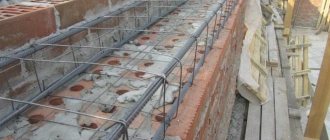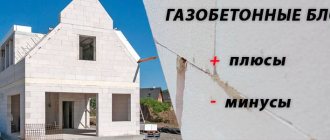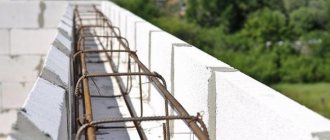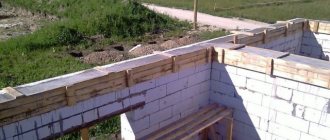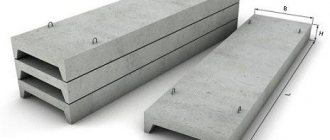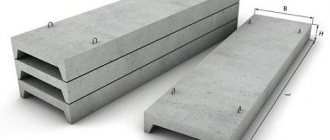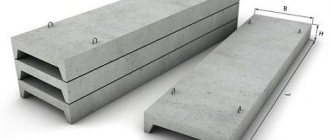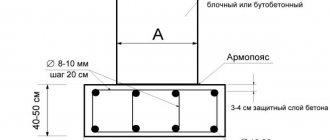An armored belt for floor slabs is created with the aim of strengthening the structure of the structure, increasing the strength characteristics of load-bearing walls, distributing the total pressure of the roof on the walls and foundation, eliminating the negative consequences of soil subsidence, the influence of external deforming loads (wind, soil shifts, daily and seasonal temperature fluctuations, precipitation and etc.).
The strength level of the entire building and the actual resistance are influenced by: the thickness and height of the reinforced belt, the grade of concrete and the properties of metal elements, the design features of the frame, the correctness of the work and compliance with all norms and standards.
Armored belt design
A monolithic belt under the floor slabs is created to smooth out the loads from the weight of the roof, interfloor panels on the main walls (their end plane). In this way, it is possible to distribute the load from the floor slabs in the most optimal way, achieving the strength of the entire structure.
Design planning includes:
- Definition of construction type
- Selection of the optimal reinforcement diameter, mesh pitch, number of layers - the power should be greater, the less durable materials are used in the masonry of walls (for example, for lightweight floor slabs, you can use a not very powerful belt)
- Calculation of dimensions in accordance with area, design features
- The thickness of the armored belt is determined - usually equal to the thickness of the walls
Depending on the place of use, the armored belt can be:
1. Grillage – is a support for the foundation, is made in a special trench at a depth selected in accordance with the weight, number of floors, dimensions and other characteristics of the building.
2. Basement - created under all load-bearing walls to distribute the load on the foundation, the height is 20-40 centimeters, the width is equal to the thickness of the walls, it is made with 12 millimeter reinforcement, and is laid with waterproofing.
3. Interfloor reinforced belt for floor slabs - installed after each floor, strengthening the walls and increasing rigidity, preventing movement and deformation, distributing the load evenly.
4. Unloading - under the roof, simplifies the creation of a rafter system, secures the mauerlat to the wall, levels them horizontally, distributes the weight of the roof over the entire perimeter, preventing point loads.
Options for attaching the Mauerlat to the armored belt: anchors, studs and others ↑
The support beam must be treated before fastening to protect it from rotting and ignition. To make the Mauerlat monolithic, it is spliced in a special way - either with a straight lock or an oblique cut. As for how to attach the Mauerlat to the armored belt, the most common methods use the following scheme:
- holes are drilled in the support beam itself;
- the Mauerlat is mounted on studs or anchors;
- installation is carried out through a layer of roofing material;
- fastening is done using a large washer and nut;
- after tightening, it is advisable to secure the connections with locknuts;
- the remnants of the protruding elements are cut off with a grinder.
how to attach a power plate to an armored belt
What is the armored belt made of?
When considering this issue, it is necessary to take into account the preparatory work and the design itself. At the preparation stage you will need formwork. To construct collapsible formwork, planed wood in the form of special panels is used, while the stationary structure is usually created from polystyrene. In this case, it is important to ensure the tightness and rigidity of the formwork structure, so materials must be selected carefully.
Reinforcement with reinforcement is carried out using the following materials:
1) Concrete mortar mixed with cement grade M400 and higher. The solution is poured into the formwork frame, which contains the reinforcing mesh. When concrete hardens, it creates a power circuit along the perimeter of the main walls that can withstand various types of loads.
The solution is prepared according to a standard recipe from sand, crushed stone, and cement. Concreting is carried out in one go, with obligatory compaction with a vibrator to eliminate air cavities inside the slab.
2) Steel rods with a diameter of 8-10 millimeters with a corrugated surface. The rods are cut to the required sizes and tied with a special knitting wire into a rigid frame. Typically, the structure is made up of four rods arranged longitudinally and connected by transverse pieces of wire of the required size with a diameter of 6 millimeters. The mesh is made with square cells, the size of which depends on the diameter of the reinforcement used and calculations.
Laying brick walls over slabs
Is it possible to lay a brick wall on a floor slab? Laying bricks on top of floor slabs is permissible for all types of reinforced concrete slabs.
Work is carried out both along and across the slabs, taking into account the developed construction plan. For example, the walls of a partition can be laid out as a whole brick, half or a quarter - it depends on the thickness of the wall and the calculated mass.
At the same time, the height of the room, the mass and characteristics of the working brick are taken into account (hollow material weighs less than solid material). The length and width of the slabs, the type of reinforcement, and the permissible load level matter. Therefore, in each case of construction, installation is carried out individually, in accordance with the calculations made.
On prefabricated slabs, load-bearing walls from the inside are laid directly along the joint. The joint itself is filled with ready-made concrete. A cement base is placed between the floor slab and the brick.
Particular attention is paid to the places responsible for the stability of the walls from the outside and inside. Plates that have hinges are attached to each other using the provided mounting loops (they provide reliable adhesion)
When laying bricks on slabs, it is imperative to adhere to general regulatory building rules and use anchors to fasten the slabs to each other.
Correct masonry
The technology of laying walls on floor slabs consists of the following steps:
- Check the position of the laid slab. The rough side should be facing up and the smooth side facing down.
- Adjust the product along the bottom side using special equipment and tools.
- The slabs must rest on 2 short sides (load-bearing walls). Check that there are no gaps between them.
- Prepare concrete mortar.
- Internal walls are laid only after the load-bearing walls are ready, with the slabs laid (if the house is multi-story).
- Laying should be carried out by a well-coordinated team - this saves time and makes the process more efficient, especially when a construction crane is involved in the process, the services for the use of which are charged hourly.
- The laying of bricks is carried out on a cement cushion, with the obligatory observance of the rules of dressing and tapping.
- If it turns out that a piece of the slab is missing, then the fragment can be made independently, using formwork, supports, reinforced material and concrete composition.
It is necessary to seal the seams and use anchors after laying the slabs, before laying the bricks.
In the process, they use a slab calculation scheme and try to make high-quality and even masonry. The last row of bricks (top), from the inside, is made of bonded bricks. Brick laying is carried out in full thickness, up to the design ceiling bottom.
Height and thickness of armored belt
When creating a reinforced belt with a square section, its height is usually equal to its thickness. Rectangular designs assume that the height exceeds the width by 1.6 times.
The grillage should be 30-50 centimeters high, for soft unstable soil it is increased to 80 centimeters, sometimes up to 100. The height of the reinforced belt for basement-type floor slabs should be 20-40 centimeters, for interfloor ones - about 40 centimeters.
The thickness of the reinforcing contour must be equal to the width of the load-bearing walls of the structure. Although, in some cases, technology makes it possible to reduce the thickness of the belt, taking 0.7-0.8 of the thickness of the walls (if thick, lightweight blocks are used in the construction of buildings).
What types of fittings are there and their features
As a rule, the armored belt is classified according to its position in the building:
- Interfloor - it is made between the upper and lower floors and covered with floor slabs.
Basement - traditionally installed under all load-bearing structures and serves to balance the load on the foundation.
Unloading - placed under the roof. Significantly simplifies the process of installing slings.
A grillage is an integral part of a pile-grillage foundation, erected on top of pre-installed piles.
When it is necessary to strengthen building structures with a reinforced belt
An armored belt may be needed to implement the following tasks: increasing the strength of load-bearing walls, creating a level base for installing interfloor panels, uniformly distributing different types of loads, preventing wall deformation, reducing the negative impact of external factors on the building, ensuring maximum structural stability, increasing the safety margin.
When it is necessary to create an armored belt:
- In multi-storey construction, where this is prescribed by building codes
- When constructing walls made of porous materials (aerated concrete, cinder block), which can wrinkle and collapse
- If construction is carried out on soft soils and there is a possibility of settlement, the monolithic belt will act as a screed and will not allow cracks to appear
- When the foundation is shallow or made of prefabricated blocks
- The house is being built in a seismically active zone
The need to install a reinforced concrete belt can be avoided in cases where the main walls are built from brick or block with good strength characteristics, and the foundation is poured below the freezing point of the soil. In other cases, the question of whether an armored belt is needed for a monolithic ceiling is not raised at all: the reinforcement contour becomes a mandatory element of the structure.
Reinforced belt under prefabricated and monolithic reinforced concrete floors
In this case, the contour significantly increases the load-bearing capacity of walls built from blocks with a cellular structure, eliminating problems caused by the porosity of concrete and its instability to deformation. The reinforced belt allows you to evenly distribute the loads from the roof and interfloor ceilings, eliminating local forces, which often cause cracks.
In addition, this type of structural strengthening protects the building frame from cracking, smoothes out the effects of sudden temperature changes, and significantly increases the service life of the masonry. Reinforcement from reinforcement and concrete connects the entire frame of the structure and the floor slab into a single power circuit, which is very important.
Getting ready to make a reinforced belt for floor slabs: building materials and tools
To pour a monolithic reinforcing belt, it is necessary to calculate the consumption and purchase the following materials: plywood and planed boards (or polystyrene in sheets) for formwork, all components for concrete mortar (gravel or crushed stone, cement, sand), steel reinforcement for the structure itself and binding wire for its assemblies, polyethylene film (seals the formwork), fasteners (nails, screws, self-tapping screws) for assembling the formwork structure.
Tools that may be needed for work:
- Concrete mixer for preparing concrete mixture
- Hand hook for tying reinforcement
- Grinder + metal circle for cutting steel rods
- Plumb + building level for measurements
- A device for bending reinforcement - if rods of increased diameter are used
Technology for constructing a reinforced belt (main stages)
- Preparing the base, cutting blanks for the formwork structure
- Assembling formwork from the selected material
- Cutting rods in accordance with specified sizes and in the required quantity
- Assembling the frame - knitting rods with wire
- Preparation of concrete solution
- Filling the formwork with mortar - preferably in one go, tamping with a vibrator or manually to remove air cavities
- Spraying concrete with water to avoid microcracks
- Dismantling the formwork after the concrete has hardened
For houses built of brick, it is possible to create a belt from this material. The contour is constructed during the process of laying the walls, the design corresponds to the features of the building. For a brick belt, there is no need to form formwork, since the reinforcement is placed directly on the brick. When using mesh, you need to choose sheets with a rod thickness of at least 5 millimeters.
Brick openings and lintels
A loaded brick lintel carries the risk of structural failure or masonry shifting if the vertical mortar joints are empty or not fully grouted. To prevent this from happening, it is necessary to control the evenness of the horizontal rows of bricks and correctly tie the bricks in the masonry. Mortar for lintels in brick walls is used grade 25 and higher. The maximum height of an ordinary floor is five rows of bricks, the length of the floor is ≥ 0.5 meters of the width of the construction opening.
The brick lintel is built based on formwork made from magpie boards. The bottom layer of cement mortar is laid with a thickness of ≥ 2 cm, and in this layer it is necessary to lay several rows of smooth reinforcing bars Ø 6–8 mm along the length of the lintel. Metal lintels are laid one per half-brick, and there must be at least three of them along the entire length of the ceiling. Since the reinforcing bars in this design take on tensile forces, the bars must be launched beyond the ends of the opening by 0.25–0.3 m, and their ends must be bent onto the wall surface.
The formwork frame will rest on bricks protruding from the wall, which, after dismantling the wooden frame, are chipped or sawed off. With a floor width of ≥ 1.5 m, the lower part of the deck must rest on circles installed on the end side.
The process of constructing a lintel begins after the wall bricks have been laid to the floor level. In order for the support of the lintel to be strong and reliable, you first need to make a brick support heel, and the plane of the support platform is determined by the deflection of the support along the vertical axis. On the assembled formwork, bricks are laid across the frame. When calculating the lintel, determine the number of rows on the formwork surface using conventional markings, which are carried out in such a way that the number of bricks on the floor is odd. Rows are counted in the horizontal plane. The odd brick is along, and it should be located strictly vertically and in the center of the brickwork.
Bow and wedge lintels are laid simultaneously on both sides from the supporting heel to the castle brick so that the row ends at the castle with an odd brick in the center of the masonry. Use a construction cord to check the evenness of the mortar joints. A wedge lintel cannot be erected if the opening length is more than two meters.
What formwork materials can be used
The first stage, which involves reinforcing the reinforced belt under the floor slabs, is the creation of formwork. The width is equal to the size of the wall, the thickness is about 30 centimeters. Most often, planed wood 2 centimeters thick is used, fastening the boards with screws 5 centimeters to the top of the wall, additionally strengthening every 100 centimeters or more often.
The side edging is fixed with strips or threaded rods. The boards must be fixed horizontally, level, airtight, and securely.
They also use moisture-resistant plywood, impregnated with pre-used oil, which will facilitate installation. Extruded polystyrene slabs are most often chosen for arranging thermally insulated formwork.
Installation of fittings
Reinforced concrete tape is performed with a certain sequence of work: first, the rods are cut, then they are laid on clamps or pads along the formwork, tied with wire (this is the bottom layer), transverse rods are installed on them and the top layer is attached. Afterwards, the elements are fastened with wire or threaded rods.
Usually, ribbed rods with a diameter of 12 millimeters are used, and they are used to assemble a parallelepiped or ladder. But it is better to take 12 millimeters for the first layer, 6 millimeters for the second, and 10 for transverse fastening. The transverse frame can be welded in the center and along the edges, and the entire volume of rods can be tied together.
The frame must be recessed in the concrete solution by several centimeters, the distance from the edges is 5 centimeters. The knitting wire can be of a minimum diameter, since its thickness does not affect the strength of load-bearing external or internal structures, but significantly increases the time and money required to complete the work.
When both layers of mesh are ready, they are laid, welded together at the edges and in the center, creating a frame with a square or rectangular cross-section. It is better to carry out this stage of work in formwork, so that later you do not have to transport the part, the large weight of which is noticeable.
In the process of assembling parts into a single mesh, welding is not used - it is enough to overlap 20-30 centimeters between the parts. The entire structure must be evenly located inside the formwork; a building level is used for measurements.
If the reinforcement is laid in polystyrene concrete or other blocks, then grooves are first made with a wall chaser, they are cleaned of dust, moistened, and filled with softly mixed concrete mortar or glue. Then they lay corrugated metal rods with a diameter of 8 millimeters in the grooves, remove excess adhesive, and continue the construction process.
Work order
A reinforced reinforcement belt for aerated concrete, depending on the formwork used, can be made in three ways:
- using wooden shields;
- using partition aerated concrete blocks;
- using special U-shaped aerated concrete blocks.
Wooden formwork panels
Board construction
The construction of a monolithic belt using wooden panels consists of the following operations:
- production of wooden panels;
- production and assembly of reinforcement cage;
- laying concrete mixture;
- dismantling of shields;
- curing.
The edged board for formwork should be 2.5–4.0 cm thick and 200–300 mm wide. Also, when assembling panels, bars of measured length with a thickness of 40x40 mm are used. For fastening, nails or wood screws are used.
Monolithic belt diagram
Instructions for pouring a monolithic belt with your own hands at a construction site:
- The wood is laid out on a separate area and the size is selected so that the height of the finished shield is not much greater than the height of the future belt.
- The boards are knocked down into panels in sections up to 2.5 m long (the length is for ease of assembly on the walls, you can do more).
- You can immediately install internal bars to screed the lower part of the structure. When installing them, it is necessary to take into account that the panels are overlapped with the wall - the lower part of the formwork is overlapped with the wall up to 30–50 mm. Therefore, the bottom of the block should be at this level.
- The section is lifted up and placed on the wall.
- The boards are leveled (vertical) and fixed with horizontal ties (bars). To begin with, one is enough, otherwise it will be difficult to insert frames.
- Thus, the remaining sections are lifted and mounted. Using horizontally installed bars (top and bottom), the sections are fastened into a single structure.
- All walls are built in this sequence.
Frame assembly
Reinforcement cage manufacturing process:
- First, clamps are made on a bending machine and tightened with knitting wire.
- At the same time, from pieces of reinforcement 1.0–1.2 m long at an angle of 90 °, additional elements are bent to connect the frame sections at the corners of the walls.
- Then take four rods and thread them into vertical clamps.
- Assembly of the frame begins from the center of the section, gradually moving in different directions (towards the edge).
After preparing all the details of the metal frame, it is lifted and placed in the formwork, not forgetting to maintain the tolerances provided for by the technical specifications:
- the distance from the shield to the frames should not be less than 50 mm;
- the displacement of the frames from the central axis of the walls should not exceed 100 mm or more than 0.25% of the measured length;
- deflection of the spatial frame - no more than 0.175% of the control length.
Then the concrete mixture is prepared and poured into the formwork. Using deep vibrators, the belt is compacted and left until the required strength is reached (at least 72 hours).
Flooded area
After the stated exposure, the belt is freed from the formwork and they wait for it to finally dry under natural conditions.
How to pour concrete
To fill a monolithic frame, use a concrete solution, following the recipe: 5 parts gravel, 3 parts sand, 1 part cement, completely mix the dry components, gradually add water until a thick solution is obtained.
The stage is performed in one go, having prepared the required volume of the mixture in advance. In the process of filling the formwork, it is necessary to remove voids with a vibrator or bayonet, check the horizontal level, eliminating differences. Then you need to carefully plan the surface and cover it with plastic film.
During the hardening process, be sure to periodically moisten by spraying. The concrete hardens within 3-5 days, and it will be possible to lay slabs on it, extending 12 centimeters onto the walls for reliability. When the layer has completely hardened, you can dismantle the formwork (but not break it) with a nail puller or crowbar.
Insulation of armored belt
The reinforcement circuit acts as a conductor of heat, so without proper insulation, cold bridges will appear, significantly worsening the thermal insulation characteristics. Before finishing work begins, insulation is placed in the recesses remaining after dismantling the formwork.
Typically, insulation is created to the height of the belt along the entire facade. In two-story buildings, if there is a belt between the first and second floors, including after the second floor under the Mauerlat, two insulating belts are created along the facade.
Most often, polystyrene foam 8 centimeters thick, grade PSB-S 25, is used; the height of the insulating contour is calculated as follows: 15 centimeters + height of the reinforcing belt + 15 centimeters, attaching the insulation below and above the contour lines at the specified distance.
To make the thermal insulation layer durable, a drip with a drip is installed in the upper part, which will drain melt and rain water from the reinforcing circuit. The ebb is placed with a slope from the wall, made of galvanized sheet steel and coated with polyester. They are fastened by cutting above the insulation belt, the top edge is brought in, then sealed and secured in increments of 30 centimeters.
Instructions for installing the reinforcing belt
The technology for constructing a reinforcing belt is no different from the construction of a conventional foundation strip. An exception is the connection nodes of the armored belt with the ceiling or Mauerlat.
Blueprints
A monolithic aerated concrete belt for floors or beams is made according to the drawing, which is included in the project:
The armored belt under the Mauerlat will have a slightly different appearance:
Materials and tools
In order to make an armored belt in a house made of aerated concrete for slabs, a roof or a foundation, you will need the following materials:
- formwork or lumber for its construction;
- concrete mixture M200...M350;
- reinforcement with a cross section of 10-12 mm;
- metal anchors;
- film waterproofing.
Expert opinion Vitaly Kudryashov builder, aspiring author
Ask a Question
Tools you will need: a concrete mixer, a trench for pouring concrete, a hook for tying reinforcing rods, an angle grinder, a hammer, a tape measure, a building level, and welding.
How to connect an armored belt with aerated concrete masonry
The reinforcing belt and the wall on which it rests must create a single monolithic structure. This is the only way the belt will fully perform its functions. You need to think about connecting the belt and the wall at the stage of laying the gas block. At a height of 0.3...0.5 m before the future ceiling, reinforcement must be made inside the masonry by installing metal anchors inside the aerated concrete blocks, which protrude 10-20 cm above the surface of the masonry. These anchors are connected to the reinforced frame of the belt, forming a monolithic structure that can effectively absorb loads.
Armored belt device
The technology includes the following stages:
- Surface preparation - the top layer of aerated block masonry: removing dust, degreasing.
- Installation of formwork: removable - from lumber, non-removable - from heat-insulating materials.
- Knitting a reinforcing frame from reinforcement with 4 threads.
- Laying the reinforcing frame inside the formwork.
- Bundle of anchors and reinforced frame by welding.
- Preparation or ordering of concrete mixture.
- Layer-by-layer concreting of the reinforced belt to the required height.
- Concrete surface care.
- Laying waterproofing after reaching the design strength.
The armored belt for aerated concrete under beams is ready. After 28 days, construction can continue. In the case when it is impossible to wait for the concrete to gain strength by design, you can use ready-made reinforced concrete products to construct the belt.
